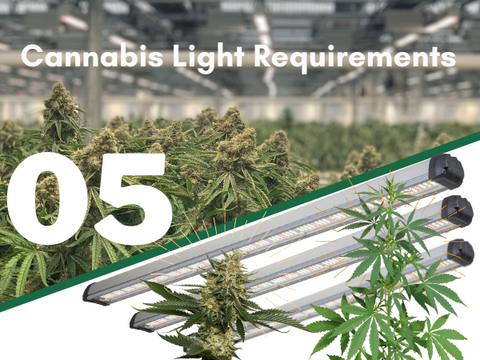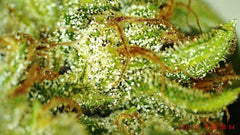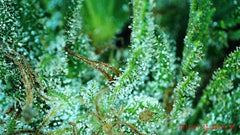A new year means a new grow, and with every new grow means improvement on your systems and most of all an improvement on your yields.
This is the pursuit that happens with every successful and not so successful crop cycle of cannabis cultivation. Cultivation can be frustrating if you put months of work into a low yield. We have put together a list of ten tips for getting the most flowers out of your grow in 2022.
Cannabis is literally found everywhere throughout the world but can only have great yields under certain conditions. You can grow outdoors, where you have the advantage of natural sunshine and atmospheric conditions or you can grow indoors, where it tends to be more reliable however, as you have a lot more control over that environment and increased capital costs. Whichever you choose, there are a number of principles to keep in mind for maximizing yields.

Before you plant anything make sure you know if you are cultivating an autoflowering or photoperiod strain. This is critical in planning your nutrient load and light loads for your plants to ensure that you have ideal conditions. Once you determine that you need to have reliable genetics from a reputable breeder. I would recommend Humboldt Seed Company due to their reliability, production, yield, and vigor. They tend to win at the Emerald Cup year after year and release outstanding genetics that focus on terpene and cannabinoid production. You can find their 2022 Emerald Cup Edition Seed by clicking on the image to the right or here. Once you order your seeds and prepare your set up you are ready to grow Good Medicine! Here are the 10 ways (in no order of importance) to improve the chances of your photoperiod dependent plant producing a great harvest!
1. Trellising – Hold Them Up & Watch Them Grow
If you are really pushing your plants indoors and outdoors you will find that they have a hard time holding up their large main branches and thus colas as flowering comes around. Cannabis can be manipulated during vegetative growth to bear the yields of flowering in a more mature stage. Trellising is a basic cultivation technique utilized in backyard and commercial agriculture alike. This is where wooden, metal, or plastic structures are built to aid and guide the growth of plants. Any such strong material can be arranged in a mesh or simply as supportive rods. These can keep your plants separated and sturdy whether you’re grow setup is horizontal or vertical. This reduces the stress of heavy yields and increases airflow in the canopy. Keep in mind that you need to only have clean, pest free sources of trellising materials in your grow.
2. Plant Training – Vegetative Manipulation Allows for Optimal Flowering
“A man is born gentle and weak. At his death he is hard and stiff. Green plants are tender and filled with sap. At their death they are withered and dry. Therefore, the stiff and unbending is the disciple of death. The gentle and yielding is the disciple of life. Thus, an army without flexibility never wins a battle. A tree that is unbending is easily broken.” This is Tao 76, and it encapsulates cannabis plant training.
During the vegetative phase of the photoperiod your plant is resilient and more vulnerable to stresses. The only path to great yields is guiding the development of your plants during this phase of growth through low stress training (LST). This is when you spread out the main stem and side branches carefully with string. This causes your plant to respond to the stress by growing thicker branches and growing outwardly in a bush form.
Training is a great tool for any cultivator to implement during their grow to improve their yields, but it is important to understand that training is just one of the critical steps to improve their yield. Watering, nutrients, lighting, airflow, and humidity are the fundamentals that must be mastered to increase the overall amount and size of your harvest. LST is primarily carried out during the vegetative and early flowering stage when the plant is most malleable and cannot be done later in the flowering stage.
Low Stress Training (LST)
Maximize light exposure in your plant canopy by gently manipulating plants to enhance bud growth and development. LST can be utilized in both vegetative photoperiod plants and autoflower plants, indoors and outdoors. It takes skill and increases labor cost at a U curve depending on the efficiency of the cultivator and yield. Different methods can be utilized depending on your grow.
Tie-Down Method
This method of cannabis cultivation lets you train your plants to grow in the exact shape and size you want, giving indoor growers the ability to make the most out of their grow space.
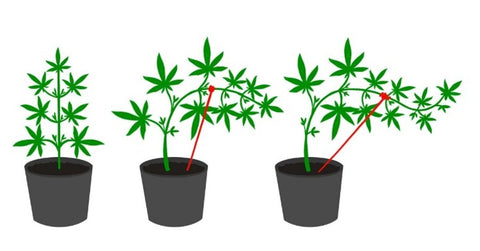
The idea behind the tie-down technique is to bend and gently tie-down your plant’s branches and leaves so they develop into an even canopy and promote multiple bud sites and allow more light through. This will result in more even and increased light to all your plants, resulting in much bigger yields from the same grow lights compared to plants that were not trained.
Sea of Green (SOG)
This method of cannabis cultivation refers to the end goal being a room filled from wall to wall, with small-sized uniform Cannabis plants. Purposely grown in small pots with a very short growing period, no training applied and packed closely together. This method is the inverse of the Tie-Down Method because it decreased the overall yield of each plant but increases the number of plants per square foot of grow.

This method yields smaller plants with a faster crop cycle. It works best with autoflower cultivars and lowers the amount of media and nutrients needed to complete the crop cycle.
Screen of Green (SCROG)
This is very similar to Tie-Down training but instead of individual tie downs or clips you utilize a grid of string that guides the plant in a similar manner to the Tie-Down method through the grid.
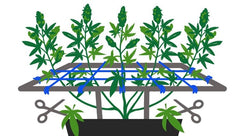
Once the plants reach the net the training is relatively easy, you just need to push the branches that have outgrown the net back down, this will make the branches grow horizontally and slowly create a large and even canopy.
High Stress Training (HST)
This type of plant training involves more intensive and encompasses controlled damage to plants in an effort to increase light exposure and divert resources to viable bud sites for a potentially increased yield. These methods are not recommended for autoflowering cultivars because stress on these plants diminishes return and increases the likelihood of total crop failure. HST methods are recommended for controlled photoperiod plants. When utilizing HST methods you may need to prolong vegetative growth to ensure adequate repair time for the plant.
Topping
It is as simple as it sounds. One of the easiest HST methods to employ is to simply cut off the top of the cannabis plant during the vegetative growth cycle. This will consequently produce two stems. This means two colas versus the central single cola growth. Topping can be repeated more than once to create multiple colas and bud sites. Remember that more topping equals more time for the plant to recover during the vegetative stage.
off the top of the cannabis plant during the vegetative growth cycle. This will consequently produce two stems. This means two colas versus the central single cola growth. Topping can be repeated more than once to create multiple colas and bud sites. Remember that more topping equals more time for the plant to recover during the vegetative stage.
Main-Lining
Out of all the HST methods this is one of the more stresses inducing one on the plant. It is an intensive combination of the Tie-Down Method and the Topping Method that will result in horizontal growth and the potential of 8 bud sites (if you do this 3 times carefully). Keep in mind you will need to let the plant recover after each step.
3. Increase Your Container Size – Size DOES Matter!
It is pretty obvious that size matters in the cannabis world, I mean you are here because you want to increase your plant production and have a larger yield at the end of each plant cycle. One of the more obvious ways to accomplish that is increasing the container size you are growing out of. Obviously, this depends on the space you have to grow your plant and how much you can afford to scale up. With more media and room your plant can grow larger and produce a larger harvest size.
4. Increase Your Light Intensity – LIGHT IT UP!
If you have not read our resources on Cannabis Light Requirements, please brush up here!
You need to maximize the available light with direct and evenly distributed light throughout the grow canopy. You should always keep in mind the distance that is required for your lighting set up. By increasing the intensity of the light source will boost the photosynthetic process further and will result in more bud development and growth.
5. Defoliate – Out with the Old
Defoliation is the process of removing dying and useless leaves from a cannabis plant. This process frees up energy for bud growth and further development by selectively removing the largest and oldest fan leaves during the both the vegetative and flowering photoperiod while not damaging any bud sites.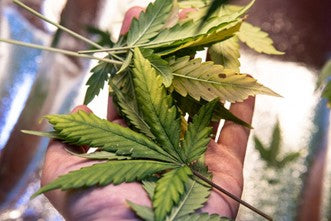
This process can be done during both photoperiod stages but should be done selectively. During vegetative growth it can cause stress if done incorrectly or too frequently. Doing this during the vegetative stages could increase stress on the plant potentially stunting growth. To defoliate your plants, you are going to want to start at the bottom (oldest leaves first) and remove any yellowing and wilting leaf materials. Do not be too aggressive and remove healthy leaves because this will halt photosynthesis. Also consider removing leaves that don’t receive as much light because they are utilizing more energy than they are creating.
Defoliation in theory frees up energy, allows for more light to access the bud sites, and potentially give you higher yields. The plant will have less appendages that divert energy from bud sites but rather harness energy and in turn give you faster growth. By removing fan leaves late during flowering you also decrease the chances of mold because you are removing the fan leaf that holds high moisture content.
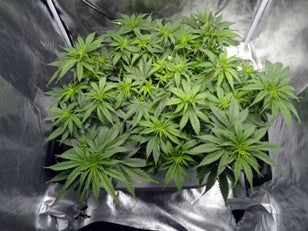

3 Defoliation Sessions
-
- Only considered during indoor growth due to restricted light, canopy space, and airflow.
- Use only sterilized and disinfected blades to minimize disease and infection risk of the plant.
-
- Do not take too much, start with the oldest part of the plant first (bottom fifth part of the plant) and remove only the largest leaves,
-
- Remove all the plants in the shadow of the light.
-
- Defoliate during vegetative growth only to free up light and make the plant less bushy.
-
- Defoliate the week before the photoperiod shift to 12/12
-
- Defoliate 3 weeks into the flowering photoperiod
-
- Give the plant 14-20 days of recover in between defoliation sessions
-
- Do not take more than 20% of the plants fan leaves during a defoliation session.
6. Climate Control – Ideal Conditions Equals Maximum Yields
Obviously avoiding unnecessary heat stress and freezing cold will help your plants maximize their growth potential and yields. These temperature stresses will damage your plants, cause stresses that divert nutrients, and decrease your finishing harvest. Indoor grows have a big advantage because of the ability to control the temperature, humidity, airflow, and CO2 of the growing environment. Through correct ventilation you can keep the ideal temperature range throughout each stage of your plant’s life. From 70–85° F to 50-80% RH depending on the stage of growth.
Ideal Temperatures for Cultivating Indoor Cannabis
| Clones, Seeds, Seedlings | The ideal cannabis seedling temperature is between 68–77°F/20–25°C. | |
| Vegetative Cycle | This stage is best done between 68–77°F/20–25°C. | |
| Flowering Cycle | The best temperature for flowering cannabis is between 68–77°F/20–25C°. | |
| Late Flowering Cycle | Here you can lower the temperature a little bit to about 64–75°F/18–24C°. | |
| Finishing, Drying, Curing | The best temperature and humidity for drying cannabis should be at about 70°F/21C°, and humidity at 50%. Curing should happen at around the same temperature but between 58 and 65% humidity. |
Ideal Relative Humidity for Cultivating Indoor Cannabis
| Clones, Seeds, Seedlings | The ideal cannabis seedling relative humidity is between 70-80% with maximum air exchange. | |
| Vegetative Cycle | This stage is best around 70% | |
| Flowering Cycle | The best relative humidity for flowering cannabis tapering down to 50% |
7. Plants Need Air – Plants Breathe CO2
Every time we take a breath, we absorb oxygen from the atmosphere. Every time plants respirate they are absorbing the byproduct of our oxygen absorption and result of our exhale, CO2. Carbon Dioxide can help grows increase their overall yield because this increases the availability of CO2 and increases the plants uptake of the gas thus speeding up the plant’s metabolism. This is only for sealed grow rooms and experienced growers.
If all climate conditions and other horticultural factors are optimized (health of plant, nutrients, light, and conditions) carbon dioxide becomes a critical factor in increasing yield. It improves the rate of the plants Calvin Cycle and stoma regulation and can increase plant growth from 20% under atmospheric conditions to 100%.
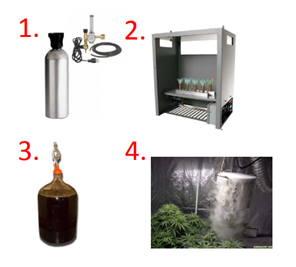
-
- CO2 Injection Systems – Carbon Dixode tanks with pressure regulators, solenoid valves, and timers are utilized to inject CO2 at regular intervals with min and max parameters set up.
- CO2 Burners – Hydocarbons such as butane, propane, and natural gas are used in specialized burners that generate CO2 while minimizing heat.
- CO2 Fermenters – (BREWERY GROW IDEA) Brewer’s Yeast, Sugar, and Water is combined to produce alcohol and CO2 through fermentation.
- Dry Ice: Solid Dry ice is housed above the plant canopy, and CO2 flows onto the plants as it subliminates.
CO2 vs Growth Rate of Cannabis
| Concentration of CO2 Parts-Per-Million | Observations |
| 300 PPM | Atmospheric Conditions, Normal Air Conditions |
| 1000-1500 PPM | Optimal Growth Rate Observed |
| >1500 PPM | Decreased Growth Rates |
| 2000 PPM+ | Toxic, 100% Failure Rate |
8. “Feed me Seymour!” – Plant Nutrition is Crucial
A key balance to get right throughout your grow to maximize your finishing yield is the nutrient and water demand for your plants. Both the vegetative and flowering photoperiod stages of growth require nutrients and water for optimal production. Vegetative growth requires high nitrogen, medium phosphorus, and high potassium levels because of all the shoot and root growth. Flowering growth requires low nitrogen, medium to high phosphorus, and high potassium for bud development and terpene production. Sulphur and magnesium are also critical throughout all stages of growth to help facilitate plant cycles and nutrient uptake.
By utilizing Comanche Compost’s Peace Pipe Potting Mixes and Nutrients you can optimize your grow and make sure nutrients are available in your soil.
9. A Dab Will Do – Molasses
It may seem like an old wife’s tale but adding molasses to your grow can add a couple more ounces to your finished harvest. Molasses is sugar, sugar fuels your plants metabolism and is packed with nutrients and minerals that are beneficial to your plant. Molasses also feeds the beneficial bacteria in your soil that helps send nutrients to your plant’s roots. It serves as a type of chemical messenger that helps promote health throughout the cannabis life cycle. The production and distribution of sugars is something cannabis does naturally, but it can use assistance in the form of various practices and supplements. Just make sure your molasses is unsulphured.
Molasses contains a wealth of nutrients that help to drive plant development and soil health, including:
-
- Carbohydrates: These simple sugars serve as a life-giving energy source to beneficial microbes in the soil. As you feed bacteria and fungi in the rhizosphere, they multiply and help plants tap into nutrients.
-
- Calcium: This mineral plays a crucial role in plant physiology, contributing to tissue growth and the structural integrity of cell walls.
-
- Iron: This essential plant micronutrient plays a fundamental role in metabolic processes such as DNA synthesis, respiration, and photosynthesis.
-
- Selenium: Selenium helps to reduce plant stress and activates important antioxidants and enzymes.
-
- Copper: Copper helps plants to create energy and respire, and also plays a role in the breakdown of carbohydrates and proteins.
-
- Magnesium: Magnesium forms the core of the chlorophyll molecule in plant tissue, meaning deficiencies can lead to a lack of chlorophyll and stunted growth.
10. Go Under the Microscope – Time the Harvest
Do not be in a rush to harvest during the last weeks of flowering. Flowering is a stage that patience rewards. There is a 2–3-week window to harvest your crop and during these weeks your buds can increase by upwards of 25%. By going under the microscope and observing the trichome color and formation you can more accurately time your harvest.
A microscope of 30x to 120x can accomplish this task and reveal to you the trichome colors that you want as a result of your grow.
Trichome Stages
| Color | Stage |
| Clear
|
Appears during vegetative state, they are clear/opaque and not ready for harvest. Will result in weak medicine and lackluster THC. |
| Some Cloudy | Not fully mature, high levels of THC low levels of the other minor cannabinoids. Energetic feel. |
| Mostly Cloudy
|
Full maturity, results in intense cannabinoids, and euphoric feel. 50% of the hairs should be dark |
| Amber
|
THC has converted to CBN, produces a body-high and is ideal for insomnia treatment |
So What’s The Key to Good Medicine?
So, how do you get bigger yields, better buds, and Good Medicine? JUST GROW! Write what you are doing and just grow! Agriculture is all about failing forward and learning with each passing day. Cultivating any plant requires skill and a major learning curve. We all want massive yields and the most potent medicine around but if you set your expectations too high without matching skill and resources you will be sorely disappointed.
In the quest for Good Medicine from your grow, take a breath, focus on the important steps of cultivation, and practice. Experience will come with time and patience.
Thanks for reading and please visit our shop to get started on your grow and stay social with us and reach out to our team if you have any questions about your soil and fertilizer needs.
Learn more about Comanche Compost Co. and stay up to date with other giveaways and cultivation pop up events around you!
